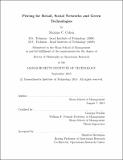| dc.contributor.advisor | Georgia Perakis. | en_US |
| dc.contributor.author | Cohen, Maxime C | en_US |
| dc.contributor.other | Massachusetts Institute of Technology. Operations Research Center. | en_US |
| dc.date.accessioned | 2016-02-29T13:59:34Z | |
| dc.date.available | 2016-02-29T13:59:34Z | |
| dc.date.copyright | 2015 | en_US |
| dc.date.issued | 2015 | en_US |
| dc.identifier.uri | http://hdl.handle.net/1721.1/101291 | |
| dc.description | Thesis: Ph. D., Massachusetts Institute of Technology, Sloan School of Management, Operations Research Center, 2015. | en_US |
| dc.description | This electronic version was submitted by the student author. The certified thesis is available in the Institute Archives and Special Collections. | en_US |
| dc.description | Cataloged from student-submitted PDF version of thesis. | en_US |
| dc.description | Includes bibliographical references. | en_US |
| dc.description.abstract | What is the right price to charge your customers? Many retailers and researchers are facing this question. In the last three decades, tremendous progress was made, both in the academic and business worlds. In this thesis, we investigate four novel pricing applications. In the first part, we study the promotion optimization problem for supermarket retailers. One needs to decide which products to promote, the depth of price discounts and when to schedule the promotions. To capture the stockpiling behavior of consumers, we propose two general classes of demand functions that can be easily estimated from data. We then develop an approximation that allows us to solve the problem efficiently and derive analytical results on its accuracy. The second part is motivated by the ubiquity of social networking platforms. We consider a setting where a monopolist sells an indivisible good to consumers embedded in a social network. First, the firm designs prices to maximize its profits. Subsequently, consumers choose whether to purchase the item or not. Assuming positive externalities, we show the existence of a pure Nash equilibrium. Using duality theory and integer programming techniques, we reformulate the problem into a linear mixed-integer program. We then derive efficient ways of optimally solving the problem for discriminative and uniform pricing strategies. The third part considers the problem of pricing a product for which demand information is very limited. We impose minimal assumptions on the problem: that is, only the constant marginal cost and the maximal price the firm can set are known. We propose a simple way of pricing the product by approximating the true inverse demand by a linear function. Surprisingly, we show that this approximation yields a good profit performance for a wide range of demand curves. In the final part, we consider green technology products such as electric vehicles. We propose a Stackelberg model where the government offers consumer subsidies in order to encourage the technology adoption, whereas the supplier decides price and production to maximize profits. We address the question: How does demand uncertainty affect the government, the industry and the consumers, when designing policies. | en_US |
| dc.description.statementofresponsibility | by Maxime C. Cohen. | en_US |
| dc.format.extent | 262 pages | en_US |
| dc.language.iso | eng | en_US |
| dc.publisher | Massachusetts Institute of Technology | en_US |
| dc.rights | M.I.T. theses are protected by copyright. They may be viewed from this source for any purpose, but reproduction or distribution in any format is prohibited without written permission. See provided URL for inquiries about permission. | en_US |
| dc.rights.uri | http://dspace.mit.edu/handle/1721.1/7582 | en_US |
| dc.subject | Operations Research Center. | en_US |
| dc.title | Pricing for retail, social networks and green technologies | en_US |
| dc.type | Thesis | en_US |
| dc.description.degree | Ph. D. | en_US |
| dc.contributor.department | Massachusetts Institute of Technology. Operations Research Center | |
| dc.contributor.department | Sloan School of Management | |
| dc.identifier.oclc | 938821441 | en_US |
